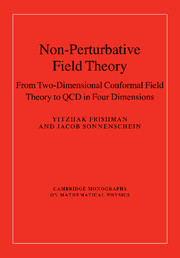Book contents
- Frontmatter
- Contents
- Preface
- Acknowledgements
- PART I NON-PERTURBATIVE METHODS IN TWO-DIMENSIONAL FIELD THEORY
- PART II TWO-DIMENSIONAL NON-PERTURBATIVE GAUGE DYNAMICS
- PART III FROM TWO TO FOUR DIMENSIONS
- 17 Conformal invariance in four-dimensional field theories and in QCD
- 18 Integrability in four-dimensional gauge dynamics
- 19 Large N methods in QCD4
- 20 From 2d bosonized baryons to 4d Skyrmions
- 21 From two-dimensional solitons to four-dimensional magnetic monopoles
- 22 Instantons of QCD
- 23 Summary, conclusions and outlook
- References
- Index
18 - Integrability in four-dimensional gauge dynamics
Published online by Cambridge University Press: 07 September 2010
- Frontmatter
- Contents
- Preface
- Acknowledgements
- PART I NON-PERTURBATIVE METHODS IN TWO-DIMENSIONAL FIELD THEORY
- PART II TWO-DIMENSIONAL NON-PERTURBATIVE GAUGE DYNAMICS
- PART III FROM TWO TO FOUR DIMENSIONS
- 17 Conformal invariance in four-dimensional field theories and in QCD
- 18 Integrability in four-dimensional gauge dynamics
- 19 Large N methods in QCD4
- 20 From 2d bosonized baryons to 4d Skyrmions
- 21 From two-dimensional solitons to four-dimensional magnetic monopoles
- 22 Instantons of QCD
- 23 Summary, conclusions and outlook
- References
- Index
Summary
Integrability was discussed in Chapter 5 in the context of two-dimensional models. In particular solutions of spin chain models based on the Bethe ansatz approach were described in some detail. Integrable models are characterized by having the same number of conserved charges as the number of physical degrees of freedom. Furthermore, the scattering processes of those models always involve conservation of the number of particles.
A natural question at this point is whether integrability is a property of only two-dimensional models or whether one can also identify systems in four dimensions that admit integrability. Four-dimensional gauge theories have generically infinite numbers of degrees of freedom and their interactions do not conserve the number of particles. Thus four-dimensional gauge theories like the YM theory are not integrable theories. However, it turns out, as will be shown in this chapter, that various sectors of certain four-dimensional gauge theories, which are derived upon imposing certain limits, do admit integrability.
The two-dimensional integrable models discussed in Chapter 5 were nonconformal ones and were characterized by a scale and hence also with particles and an S-matrix. On the other hand the integrable sectors of four-dimensional gauge theories that we are about to describe are conformal invariant. The main idea is that these special conformal invariant sectors can be mapped into two-dimensional spin chains that were described in Section 5.14.
- Type
- Chapter
- Information
- Non-Perturbative Field TheoryFrom Two Dimensional Conformal Field Theory to QCD in Four Dimensions, pp. 329 - 336Publisher: Cambridge University PressPrint publication year: 2010



